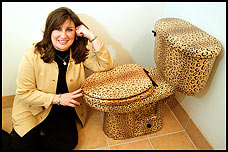James A. Parcell – The Washington Post Thursday, September 28, 2000; Page H01
Some artists create on canvas. Xenia Zampolli prefers the wet porcelain of just-molded toilets and sinks. These she embosses, embellishes, carves, signs and numbers; when they dry, she paints, glazes and fires them in a kiln for eight hours.
Leopard spots. Zebra stripes. Checks. Swirls. Elephants. Fish. Dragons. Dragonflies. Wild motifs that evoke Erte and Kandinsky. Subtle, same-shade appliques of flora and fauna. Intricate mosaics. Designs taken from wallpaper and tile.
And when her fixtures are finished, she dispatches them to smart little galleries and purveyors of upscale plumbing in Beverly Hills, Malibu and other tony shopping precincts in California. She calls them the ultimate in functional art. “I’m the only one doing this [wet porcelain] process,” claims Zampolli, 26. “I’ve never seen anything like it. The paint is actually saturated in the clay. You get a more organic look.”
Jeff Burton, owner of Bath & Beyond in San Francisco, agrees. Indeed, this past president of the National Kitchen and Bath Association who has seen countless industry innovations over three decades, was smitten by her sink and toilet sets. He bought all five pieces Zampolli exhibited at the group’s April trade show in Chicago because, he says, “she’s doing for plumbing what the dot-commers are doing for the Internet.”
Burton says 80 percent of the fixtures sold today are white, but color has been around for ages. Ancient Romans and Greeks used tinted terra cotta and multi-hued mosaic for their public and private bathing spaces. In this country, several companies have been tarting up existing fixtures for decades, including New York-based Sherle Wagner International, American Standard’s Porcher division in Arizona and the Le Bijou Collection in Miami. Custom commissions can range from exotic flowers to favorite frocks and neckties, from landscapes to pet portraits.
What Burton appreciates about Zampolli’s work is its reach and complexity.
“First of all, she’s doing animal patterns, which is very interesting. And she does matching toilets–not just the outside but inside the bowl as well. The other people, they paint an already-finished sink and they fire it again and bake the design on. Hers is actually baked into the china. And it’s not decals. The cheaper ones you see in home centers are usually decals.”
Burton describes a Zampolli buyer as “the person who wants something the Joneses up the street don’t have.”
Meet Helen Stefan Moreau of Chevy Chase, extremely proud owner of a leopard toilet. She spotted her potty in a Santa Monica, Calif., gallery last year and had it shipped to the new house she was building with her husband, Francois Moreau, a former Citronelle pastry chef.
“I love leopard, and we had thought of doing a leopard theme in our lower level. We have a billiards table with a leopard chandelier over it. So it is perfect for our downstairs powder room,” said Moreau, who heads Midtown Personnel, a legal placement service.
“People love it, they freak out over it. They come to our house and take pictures of it. They’ve all heard about it. My husband is French. His family in Biarritz has pictures of it,” she said.
Zampolli began her distinctive career after college, spending 2 1/2 years at Western Pottery Industries, which used to manufacture the fixtures near Los Angeles. “They let me work there and use as many toilets and sinks as I needed. When they moved to Canada, they gave me the molds,” she says. “About six months ago, I set up my own studio. I love functional art, and I focused on ceramics in college. When I was in school, I tried making a toilet [from scratch] and it didn’t really work out. It took a long time to figure out the paint in this process.”
The paint is actually an under-glaze she developed after much experimentation. It is applied everywhere, from the top of the lid to the very bottom of the bowl.
“I do all the carving when the bisque is still wet–all the embossments, the shaped clay add-ons, the paint and sometimes even gold leaf. When it’s dry, I glaze it and let it dry again. Then I fire it at 2,200 degrees. I have a kiln in my studio that fits about four toilets, so I work on three or four at once,” said Zampolli.
Prices range from about $1,650 to about $3,500. Add $330 for a customized seat, which alone can exceed the cost of a standard white toilet.
In the past six months, Zampolli has sold about 20 pieces–pedestal sinks, drop-in bowls and toilets. “The most expensive was a toilet. It was for the Year of the Dragon, and it had a dragon on the front, a Japanese character, little touches of gold leaf and a bunch of embossed flowers.”
She decided to make a career of bathroom art because “I love furniture. I actually used to make benches and chairs. This was like a blank canvas that I could change into a totally new art piece.”
She recently added urinals to the line, which she would love to sell to residential clients. At present, however, “they are definitely for clubs and restaurants, and maybe Las Vegas.”
Burton waxes rhapsodic about this young, unorthodox artist. “We’ve got her doing decorative computer chips on the toilets to appeal to the dot-commers, and maybe she’ll do some cartoon characters. This girl is definitely outside the box. She’s from a different planet, a very creative planet.”





